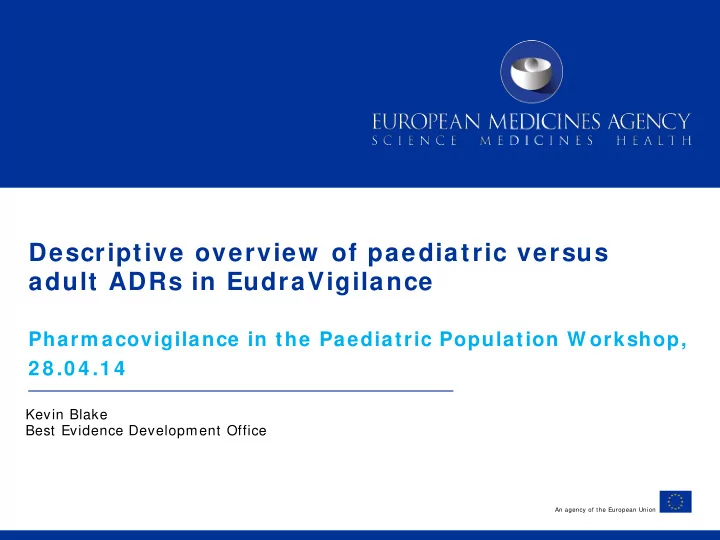

Descriptive overview of paediatric versus adult ADRs in EudraVigilance Pharm acovigilance in the Paediatric Population W orkshop, 2 8 .0 4 .1 4 Kevin Blake Best Evidence Development Office An agency of the European Union
I ntroduction Under review by Pediatric Drugs (Drug Safety) – revision 1 submitted 1
Spontaneous ADR databases • Databases systematically collecting reports of ADRs are a cornerstone of pharmacovigilance: on-going large-scale surveillance in the ‘real-world’ setting. • Several studies have provided data on ADRs in children reported to national databases e.g. EU MSs, Canada, the US. • Study in EV to provide a descriptive overview comparing paediatric versus adult ADRs reported across national boundaries to EudraVigilance (EV) as a baseline to explore if lessons can be learned 2
Methods • Reports in EV from inception of EU PV system (January 01 1995) to cut off 13 June 2013 analysed for overall numbers, age, gender, primary source (EEA/ non-EEA) Age defined as birth to last day of 17 th year inclusive • • If age not provided then, where possible, calculated from date of birth to date of reaction 3
Reporting of age Accurate age provided: 57.1% Age could be calculated in a further 18.8% 75.9% could be used in the analysis Of these 11.2% (279,359) < 18 years 4
Gender Sim ilar overall ( F 4 8 % and M 4 7 % ) but difference in the age distribution 5
Geographic origin Prim ary source Prim ary source paediatric cases 1% 1% 36% 49% 50% 63% EEA EEA Non EEA Non EEA Not specified Not specified 6
Reporting over tim e 7
Proportion of paed v’s adult cases by SOC 8
Most frequent reported PTs Number (%) of Rank PT PT Number (%) of adult reports paediatric reports 1 Pyrexia 37548 (13) Nausea 92985 (4) 2 15652 (6) Dyspnoea 83411 (4) Vomiting 3 Convulsion 12009 (4) Pyrexia 72736 (3) 4 Rash 10432 (4) Vomiting 65325 (3) 5 Headache 9512 (3) Headache 64341 (3) 6 Crying 8601 (3) Dizziness 61635 (3) 7 Urticaria 8567 (3) Diarrhoea 57071 (3) 8 Diarrhoea 7467 (3) Rash 53847 (2) 9 Nausea 7464 (3) Death 53748 (2) 10 Drug ineffective 6024 (2) Fatigue 52309 (2) 9
10
‘Top 2 0 ’ For children: 51% of total (28% in adults) For children: 13 of the 20 are vaccines (0 for adults) Therefore, DEC separated for children vaccine and non-vaccine 11 Presentation title (to edit, click View > Header and Footer)
12
13
Key findings o Descriptive overview of what has been reported cumulatively to EV to date. o Paediatric ADRs more common under the ‘general and administration site’, ‘nervous system’, ‘skin and subcutaneous disorders’ and ‘infections and infestations’ SOCs. o Small number of terms e.g. ‘pyrexia’ and ‘crying’ under the general and administrative site SOC and ‘convulsion’ and again ‘crying’ under the nervous system disorder. o Also differ in terms of substances reported - vaccines o Confirms paediatric ADRs very different to those from adults safety profile in adults not necessarily reflective of children 14
Implications for paediatric pharmacovigilance Relative concentration of paediatric ADRs around limited sets of drugs and reactions could be the focus of specific efforts to prevent ADRs. Most frequent reported reactions and substances are known associations: few surprises however did not set out to detect signals Supports that paed PhV is not limited to capturing associations e.g. continuous signal detection activities, paediatric query in EV 15
Questions and Discussion 16
Recommend
More recommend